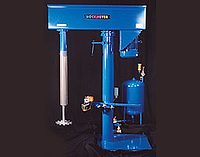The Art of Mixing: High-Speed Dispersers

The High-Speed Disperser (HSD) is the basic tool used by all paint, ink, chemical, plastic and adhesive manufacturers. Although a very simple device, the HSD is often misused or misapplied. The following outlines the basic design parameters of an HSD.
- Normal operating viscosity range = 1,000 - 25,000 cps and up to 50,000 cps max
- Motor specification = 1HP for every 10 gallons of product
- Disperser blade tip speed = 4800-5200 feet/minute
- Calculation: Blade diameter x 3.1415 x shaft rpm = tip speed (feet/minute)
- Disperser blade diameter = 1/3 mixing vessel diameter
- Disperser blade location:
- Off bottom = 0.5 blade diameter
- Under surface = 1.5 blade diameter
- Batch time at high speed (after last ingredient is added) = 20 minutes
- Hydraulic lift mounted to allow raising and lowering during operation
- Portable mix vessels up to 500 gallons
Many of the mixing problems encountered are directly related to not incorporating these basic design specifications. Using an HSD in a mixing tank or batch that is too large or too small for the HSD will result in poor-quality products or lengthy process times. For example, large HSDs are often used to make small batches such as a 10HP with a 10-inch blade in a 55-gallon drum. The blade diameter to mix tank ratio is almost 2:1 vs. the recommended 3:1. In this case, with a 10-inch diameter disperser blade, tip speeds of 4800-5200 fpm and operating in a 55-gallon drum, a deep vortex would occur, forcing the product upwards and out of the drum.

The primary purpose of the HSD is to incorporate and break down dry agglomerates into a liquid vehicle and effectively "wet" the dry particles to produce a uniform, stable dispersion with the finest particle size possible. To produce the desired dispersion results, the method used to make the batch can be as important as proper design specification and proper formulation.
A typical HSD batch is started with a fairly low level, or volume, of fluid and no dry product. The fluid level may be 50% or less of the final batch. The disperser blade is typically placed on-center and operated at a low speed. The low speed should produce a deep vortex that the dry powder ingredients can be added into. Add the dry ingredients as quickly as the liquid will absorb them. To avoid large, dry lumps from forming, do not bulk load powders. Increase the speed as needed to maintain the vortex as the viscosity increases. Continue to add the dry powders and other fluid ingredients as required. Please note that the disperser blade may be located off-center to reduce the vortex if required. Reducing the vortex will also reduce the amount of air that will be incorporated into the batch. This is especially important in water-based products.
When all of the dry ingredients have been added, you may need to scrape the side walls of the mixing vessel to remove dry materials that may have gathered along the surface of the fluid. You may also need to scrape the disperser shaft for the same reason.
At this point you are ready to run the disperser at its high speed (4800-5200 fpm) for a period of approximately 20 minutes. The disperser can be raised and lowered to eliminate "stratification" or possible layering within the batch.
After 20 minutes, a sample from the batch should be checked for "fineness of grind" using a Hegman, Micron or NPIRI drawdown gauge.
Running the HSD at high speed for periods longer than 20 minutes most likely will not produce improved results. The batch temperature will also increase greatly, which may not be good for the formulation. Higher temperatures will evaporate solvents, wetting agents or other volatile components, which may damage the product and increase the percentage of solids. To avoid high batch temperature, the mixing vessel may be constructed with a heating/cooling jacket to control the temperature.
If the mix vessel, blade ratios and tip speeds are correct and proper results are not achieved near the 20-minute batch time, the formulation may require adjustment, or a secondary or alternative process may be required.
An alternative may be a batch-style rotor-stator high-shear mixer. A secondary process could be an in-line rotor-stator high-shear mixer or, for very difficult-to-disperse products, a media mill can be used. Future articles will discuss these mixers in greater detail.
Looking for a reprint of this article?
From high-res PDFs to custom plaques, order your copy today!





